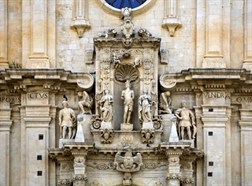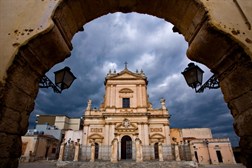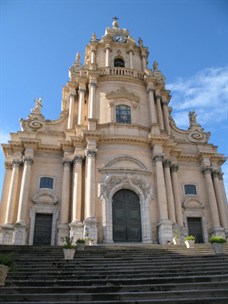Caltagirone, Ferla, Ispica, Ragusa
Among the numerous examples of Baroque art in south-eastern Sicily which were rebuilt after the earthquake of 1693, are the Church del Gesù of CaltagironeCaltagirone is a town in the province of Catania, best known for the production of ceramics. Its historic center is a UNESCO World Heritage Site together with the entire Val di Noto.. This is the church attached to the College of the Jesuits, the construction of which began in 1571 and which has also undergone several restorations and alterations after the earthquakes of 1693 and 1908 and after the Second World War. The façade has a monumental portal surrounded by niches in which the statues of Jesuit saints are placed. The statues of the Virgin Mary, Saint Joseph and Saints Peter and Paul crown the façade. The interior is full of altars with twisted columns and contains various works of art by Sicilian artists of the sixteenth and seventeenth centuries.
 At Ferla, a small town in the province of Syracuse, one can still admire the church of San Sebastiano (Saint Sebastian), built in the late fifteenth century and completely rebuilt after the 1693 earthquake. The central element of the façade is the sculptural group placed above the central portal, which depicts Saint Sebastian between two soldiers and two Moorish slaves that support the architrave (photo). The interior has a nave and two aisles and houses the relics of the saint.
At Ferla, a small town in the province of Syracuse, one can still admire the church of San Sebastiano (Saint Sebastian), built in the late fifteenth century and completely rebuilt after the 1693 earthquake. The central element of the façade is the sculptural group placed above the central portal, which depicts Saint Sebastian between two soldiers and two Moorish slaves that support the architrave (photo). The interior has a nave and two aisles and houses the relics of the saint.
 Even the basilica of Santa Maria Maggiore (Saint Mary Major) in Ispica, in the province of Ragusa, was built after the earthquake of 1693. The basilica developed around the chapel of the Santissimo Cristo (Most Holy Christ), made to accommodate the statue of the Blessed Christ at the Column that escaped the destruction of the little church which has kept it. Consecrated in 1763, it has an interior, a Latin cross divided by pillars into three naves, which houses four chapels rich in works of art and devotional objects. The façade is simple and linear. Above the central door there is a large coat of arms with the inscription De Basilicis haec una est (this is one of the basilicas), while on the central window with an architrave the Blessed Christ at the Column is depicted. On either side stand the statues of Saints Gregory and Rosalia. The bell tower dates back to the early eighteenth century, while it was 1749 when Vincenzo SinatraVincenzo Sinatra (1707-1765) was a Sicilian architect, a native of Noto. He was probably trained with his brother in law R. Gagliardi and was mainly active in his native city, but also in other towns such as Ispica. finished work on the semi-elliptical open gallery, clearly inspired by Bernini‘s colonnade at Saint Peter’s, located in front of the basilica.
Even the basilica of Santa Maria Maggiore (Saint Mary Major) in Ispica, in the province of Ragusa, was built after the earthquake of 1693. The basilica developed around the chapel of the Santissimo Cristo (Most Holy Christ), made to accommodate the statue of the Blessed Christ at the Column that escaped the destruction of the little church which has kept it. Consecrated in 1763, it has an interior, a Latin cross divided by pillars into three naves, which houses four chapels rich in works of art and devotional objects. The façade is simple and linear. Above the central door there is a large coat of arms with the inscription De Basilicis haec una est (this is one of the basilicas), while on the central window with an architrave the Blessed Christ at the Column is depicted. On either side stand the statues of Saints Gregory and Rosalia. The bell tower dates back to the early eighteenth century, while it was 1749 when Vincenzo SinatraVincenzo Sinatra (1707-1765) was a Sicilian architect, a native of Noto. He was probably trained with his brother in law R. Gagliardi and was mainly active in his native city, but also in other towns such as Ispica. finished work on the semi-elliptical open gallery, clearly inspired by Bernini‘s colonnade at Saint Peter’s, located in front of the basilica.
 Finally, the city of Ragusa certainly cannot be excluded from a route that intends to visit the symbols of Sicilian Baroque. The Cathedral of San Giovanni Battista (Saint John the Baptist), one of the largest churches of Sicily, was rebuilt after 1693. The majestic and imposing façade is divided into five parts by large columns and is flanked on the left by a high tower over 50 metres high. The interior has a Latin cross, with three naves separated by fourteen stone columns. Even more famous and representative of Baroque architecture is the Cathedral of San Giorgio (Saint George), characterized by the tower façade in which the bell tower is incorporated which is accessed ascending a high staircase. Inside, the paintings of some of the great eighteenth-century Sicilian artists worthy of note, there are numerous stained-glass windows, a majestic organ with 3368 pipes, a statue of Saint George on horseback and the great relic chest: the latter two are both brought out in procession every year during the feast of the patron.
Finally, the city of Ragusa certainly cannot be excluded from a route that intends to visit the symbols of Sicilian Baroque. The Cathedral of San Giovanni Battista (Saint John the Baptist), one of the largest churches of Sicily, was rebuilt after 1693. The majestic and imposing façade is divided into five parts by large columns and is flanked on the left by a high tower over 50 metres high. The interior has a Latin cross, with three naves separated by fourteen stone columns. Even more famous and representative of Baroque architecture is the Cathedral of San Giorgio (Saint George), characterized by the tower façade in which the bell tower is incorporated which is accessed ascending a high staircase. Inside, the paintings of some of the great eighteenth-century Sicilian artists worthy of note, there are numerous stained-glass windows, a majestic organ with 3368 pipes, a statue of Saint George on horseback and the great relic chest: the latter two are both brought out in procession every year during the feast of the patron.
